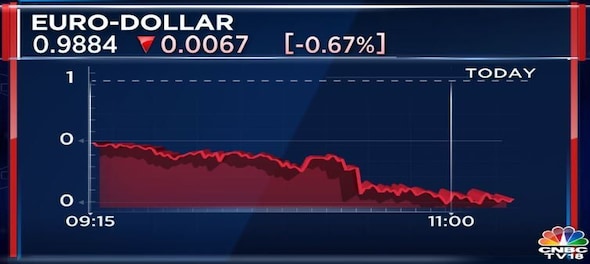
The euro fell below 99 cents for the first time in nearly two decades, while sterling was on the ropes on Monday as Russia's halt on gas supply down its main pipeline to Europe sparked concerns over energy prices and growth.
The euro slid to $0.98 in Asia trade, the lowest level since 2002, while sterling hit a new two and a half-year low at $1.14 and remained close to its pandemic trough.
Meanwhile, the US dollar index, which measures the greenback against a basket of six currencies with the euro the most heavily weighted, hit a new two-decade high, surging to a top of 110.25.
Russia scrapped a Saturday deadline for flows down the Nord Stream pipeline to resume, citing an oil leak in a turbine. It coincided with the Group of Seven finance ministers announcing a price cap on Russian oil.
The pound has also been weighed down by concerns over rising energy costs. British foreign minister Liz Truss said over the weekend she would set out immediate action to tackle rising energy bills and increase energy supplies if she is to become Britain's next prime minister, as expected.
"We can't have any confidence in the outlook for natural gas in Europe, and this is a negative for the euro. It heavily depends on Putin," said Osamu Takashima, Citigroup Global Markets' chief FX strategist.
The yen, at 140.38 per dollar, was under pressure near a 24-year low. The risk-sensitive Australian dollar slid 0.41 percent and was near a seven-week low at $0.67.
"The first order effect seems to be that the heightened geopolitical risk and consequent adverse global demand shocks will probably be the effects dominating," said Vishnu Varathan, head of economics and strategy at Mizuho Bank in Singapore.
"The adverse demand shocks in a very unsavoury geopolitical environment are probably going to trigger, and reflect, safe demand for the US dollar. The European currencies are perhaps going to be the worst hit and on the back foot."
Outsized rate hikes are on the cards this week. Markets have priced a near 80 percent chance of a 75 basis point (bp) hike in Europe and an almost 70 percent chance of a 50 bp hike in Australia.
"One would have anticipated that a hawkish ECB should deliver some kind of a tailwind to the euro. But instead what you might get is the policy tradeoff and dilemma biting in," Varathan said.
In the United States, pricing for a 75 bp hike this month has pared back somewhat after a mixed jobs report on Friday, that contained a few hints of a loosening labour market.
Fed funds futures imply about a 58 percent chance of a 75 bp hike.
Elsewhere in Asia, the offshore yuan similarly fell to a fresh two-year low at 6.95 per dollar, as worries linger over COVID-19 lockdown measures in the country.
China's southern tech hub of Shenzhen said it would adopt tiered anti-virus restriction measures beginning on Monday, while Chengdu announced an extension of lockdown curbs, as the country grapples with fresh outbreaks.
(Edited by : Sangam Singh)
First Published: Sept 5, 2022 12:05 PM IST
Check out our in-depth Market Coverage, Business News & get real-time Stock Market Updates on CNBC-TV18. Also, Watch our channels CNBC-TV18, CNBC Awaaz and CNBC Bajar Live on-the-go!


Lok Sabha elections 2024: BJP's bid for breakthrough in Kerala is an uphill battle, say experts
Apr 23, 2024 9:53 PM
2024 Lok Sabha Elections | PM's Rajasthan speech — has it anything to do with the post-poll mood of the first phase
Apr 23, 2024 3:45 PM
It's KGF 2024 and here's a look at the key characters in Karnataka
Apr 23, 2024 3:17 PM
JP Morgan: Nifty may test 25,000 if BJP wins in 2024 Lok Sabha elections
Apr 23, 2024 2:23 PM

